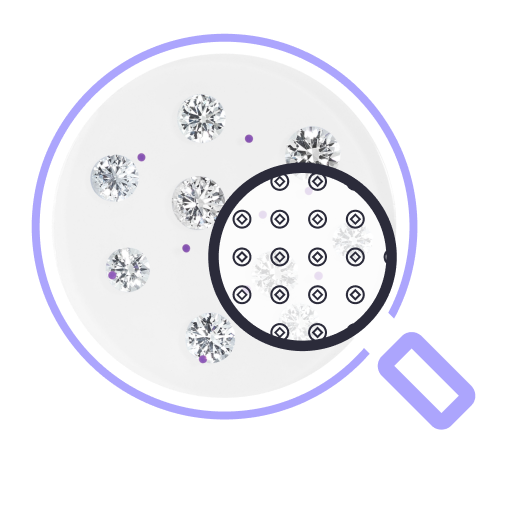Uranium vs. Diamonds:
Comparing Commodity Investments
When investing in commodities, both uranium and diamonds have emerged as newly popular asset classes. Because they are commodities, they tend to be viewed as investments with lasting monetary value. In terms of recent returns, the price of diamonds has steadily risen since January 2020. Similarly, the price of uranium has increased with the emergence of new investment vehicles.
Which is the better option for the future, uranium or diamonds?
Uranium is primarily an energy investment. Uranium is considered one of the cleanest and most sustainable forms of energy in terms of CO2 emissions. The world is moving toward net-zero carbon energy, and nuclear energy can assist countries in meeting their decarbonization targets. Compared to other kinds of power generation, uranium is more dependable and efficient.
According to Wall Street Journal: "There is too much of nearly every commodity in the world today. Then there is uranium. The outlook for the element that powers nuclear reactors may be worse than any other, and there is almost no prospect for improvement soon. Unlike other commodities, low prices won't stimulate demand. No commodity faces a pressure that uranium and nuclear fuel do, and there is little prospect of a near-term recovery."
Investing in uranium mining can be smart for investors concerned about the long-term sustainability of the world's natural resources. Uranium mines around the globe are subject to stringent environmental restrictions. Many people are still concerned with the potential uranium health effects due to its radioactive nature. While the uranium spot price has been relatively stable over the long term, it’s a reasonably safe investment that can help investors diversify their portfolios.
Currently, there is an energy crisis in Europe due to the Russia-Ukraine war. Governments are shifting their energy policies. There is a focus on energy security and energy independence. The EU released a 10-point plan on reducing their reliance on Russian natural gas, promoting nuclear energy as part of their solution. It is not only Europe - according toThe Economist, “Japan’s prime minister Kishida Fumio also made a renewed commitment to nuclear energy. He wants idled power plants to be restarted and next-generation reactors built. His government promises to deliver concrete plans by the year’s end.”
The International Energy Agency projects more than a doubling of nuclear generation by 2050. Nuclear energy provides 10% of the world's electricity from about 434 reactors. Investors view uranium/nuclear energy as the art of an energy transition solution. Note that Sprott has the world's largest uranium fund.
Uranium futures have been hovering around $50 per pound, remaining well below the two-month high of $53.5 set on October 27th. Maintenance issues in reactors in France's major nuclear energy producer led to half its nuclear fleet suspension. However, several countries, including the United States, China, and Japan, have pledged to invest in new plant development.
Investing in uranium is generally considered a safe bet for long-term investors. The world has been transitioning away from fossil fuels for decades. There are concerns about a supply shortage of uranium soon. A lack of uranium could negatively impact the price and electricity generated by nuclear power plants. As you can see below, uranium demand is projected to significantly increase in upcoming years, but uranium production will decrease.
Diamonds have been treasured historically for their beauty and look. Diamonds are a long-term store of value, an uncorrelated asset, and an inflation-resistant natural resource. Diamonds have been used for their hardness, luster, brilliance, and thermal conductivity. As Lewis Vertoman States: “The diamond has always been esteemed the rarest stone, and the most precious of all: among the ancients, it was called the stone of reconciliation.”
Investing in diamonds can be used for portfolio diversification. Like uranium, you can purchase diamonds to add to your investment portfolio. The most famous diamonds are used as gems in jewelry. Investors own only 1% of the $1.2 Trillion diamond market, owing to their limited access to diamond investments.
That is no longer the case, as Diamond Standard has developed the world's first and only regulator-licensed diamond commodities. Each diamond Coin or Bar contains an equivalent set of natural diamonds and a wireless chip containing a blockchain token for trading.
Diamonds are now available to investors as a commodity. As a result, for the first time, institutions and investors can build positions in the diamond asset class as new securities are introduced. Pent-up demand is estimated to be 15% — the smallest share of precious metals supply that investors own.
The diamond commodity will become more liquid as new securities are issued. “Anything that can bring transparency to the diamond price is a good thing,” said Karl Smithson, CEO of Stellar diamonds.
In the past, most investors viewed diamonds as an illiquid and opaque asset. Diamonds returned a pitiful 5% over the 19 years before 2021 and 41% over the last 20 years compared to the S&P 500 tripling and uranium sextupling in value across the same period. Furthermore, product prices are over 60% higher than in 2002, meaning that the inflation adjusted of an investment in diamonds would have decreased over this period. Even for determined diamond investors, the pricing of the gemstone was extremely ambiguous.
According to some sources, when the world began to reopen in 2021 after the worst of the pandemic, demand for diamond jewelry soared significantly, reaching 29% higher than the previous year. Diamonds have the potential to increase in value as investor demands grow, particularly when the diamond supply chain depletes. According to Rahul Kadakia, Christie’s International Head of Jewelry, “Diamonds are the most portable form of wealth, and that has always been true.”
Diamond Standard’s Coin price is DIAMINDX. While the coin's market price has only been available since its initial public offering (IPO) in 2021, historical price data is estimated by backtesting published wholesale diamond trading prices.
There are multiple benefits to investing in diamonds. First, diamonds are precious gemstones. This means that it is more likely that your investment will be worth more than the initial value in the future. Another advantage is that diamonds can be resold easily. If you need to liquidate your investment quickly, it can be easy to do so with diamonds.
Three Ways to Buy Diamonds Now
Diamonds have been a long-ignored investment despite its scarcity and capability to hedge against inflation. Diamond Standard invented the first and only regulator-approved diamond commodity. Each fungible Diamond Standard Coin & Bar contains diamonds with similar geological scarcity via optimization.
By standardizing diamonds, a once dysfunctional diamond market has become investible for the first time in history.
Just like the gold investment vehicles described above, Diamond Standard offers similar ways to participate in commodity investment.
In March 2021, Diamond Standard launched its Diamond Standard Coin, which is a digital and physical smart commodity. By optimizing the value of sets of diamonds, each Diamond Standard Coin has equal geological value. In March 2022, Diamond Standard offered another fungible diamond commodity: the Diamond Standard Bar. Its value is ten times the prevailing price of the Coin. Both commodities are deliverable assets with embedded crypto features.
For accredited investors seeking a convenient and cost effective investment vehicle run by experienced managers, the recently launched Diamond Standard Fund provides significant benefits. The Fund is sponsored by Diamond Standard & Horizon Kinetics and holds Diamond Standard commodities (Coins and Bars).
Last but not least, Diamond Standard is about to launch a tokenized diamond commodity. Bitcarbon is a cryptographic token representing a fraction of a deliverable commodity and is created through conversion by the physical commodity (Diamond Standard Coins & Bars) owners.
Invest in DIAMOND STANDARD CO. Offerings
Smart commodity you can hold in your hand

CARATS
Commodity Token / $100 minimum
$ 1.082
- A commodity token issued from Diamond Standard Commodities
- Instantly redeemable for physical diamond commodities
- Zero conversion costs between Carats and commodities

Diamond Standard Coins
Fungible Commodity
$ 2,730
- Contains 0.18 to 0.75 carat stones in a 35mm diameter transparent Coin
- Buy and sell on the Spot Market
- All diamonds independently graded by GIA or IGI

Diamond Standard Bars
Fungible Commodity
$ 27,300
- Contains 0.76 to 2.05 carats stones in a 70mm by 35mm transparent Bar
- Valued at 10 times the market price of a Coin
- Lowest commodity custody fees

Diamond Standard Fund
For Accredited Investors
- Shares offered in a private placement pursuant to Rule 506(c) under Regulation D
- Co-sponsored by Diamond Standard and Horizon Kinetics
- Third party administration by NAV
